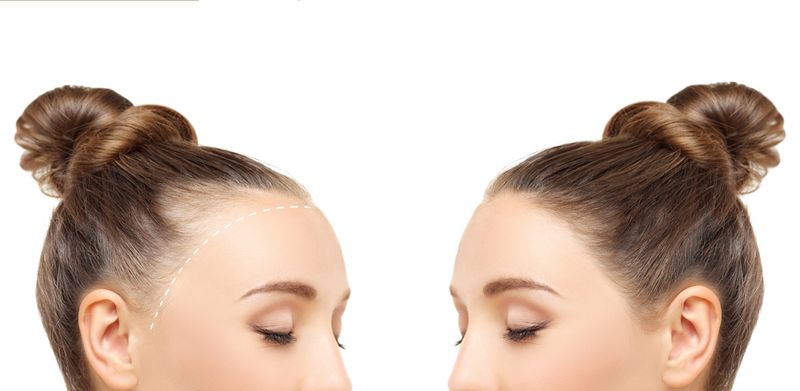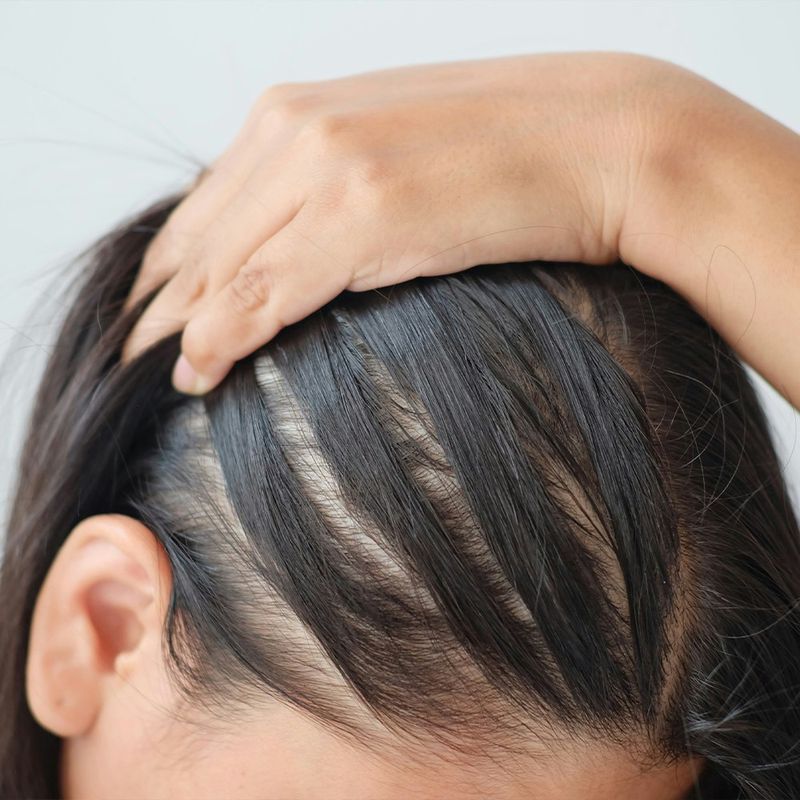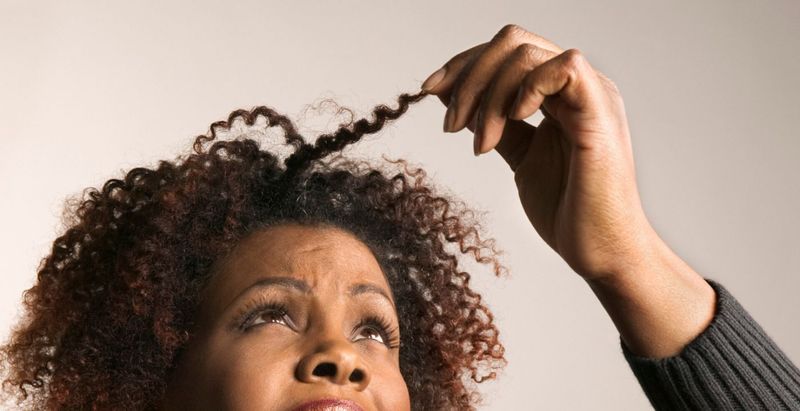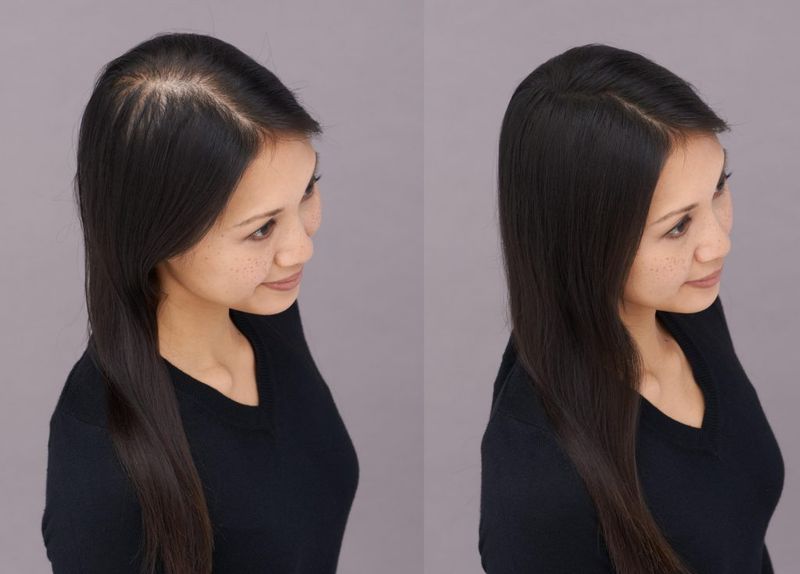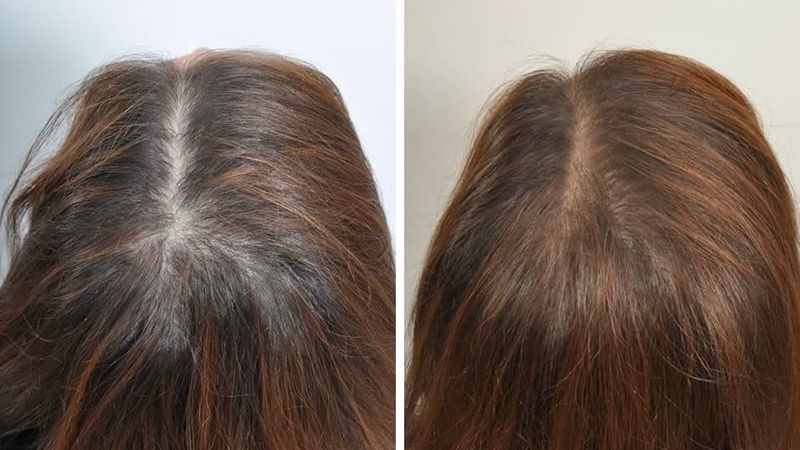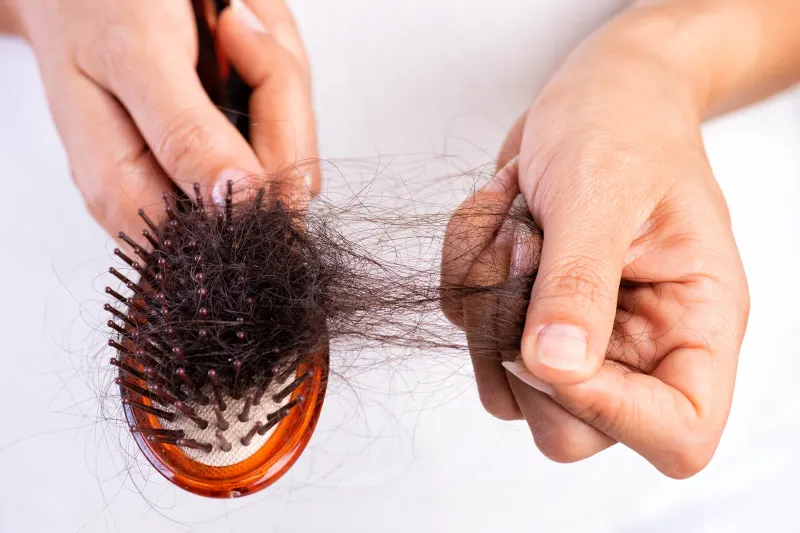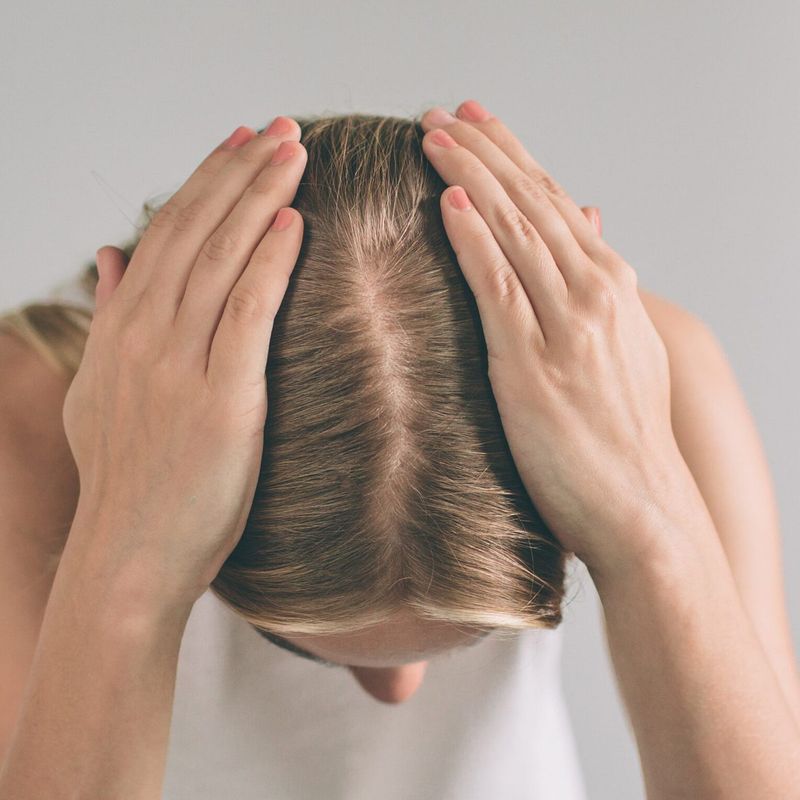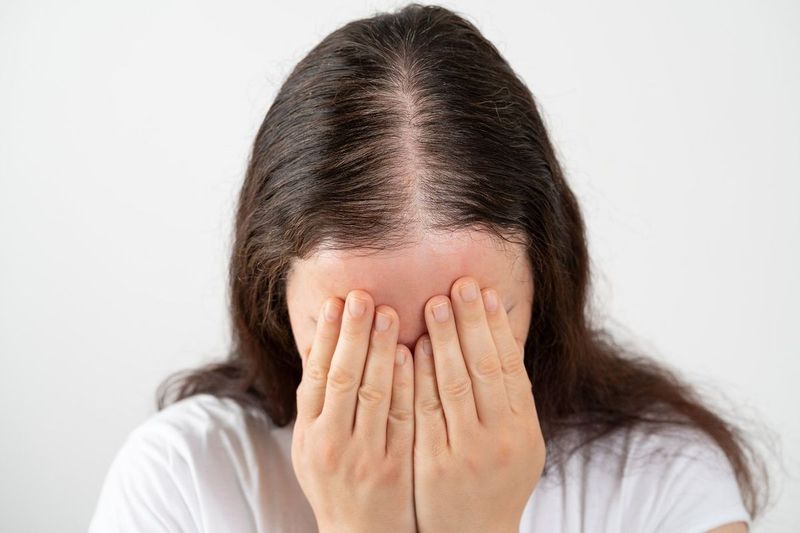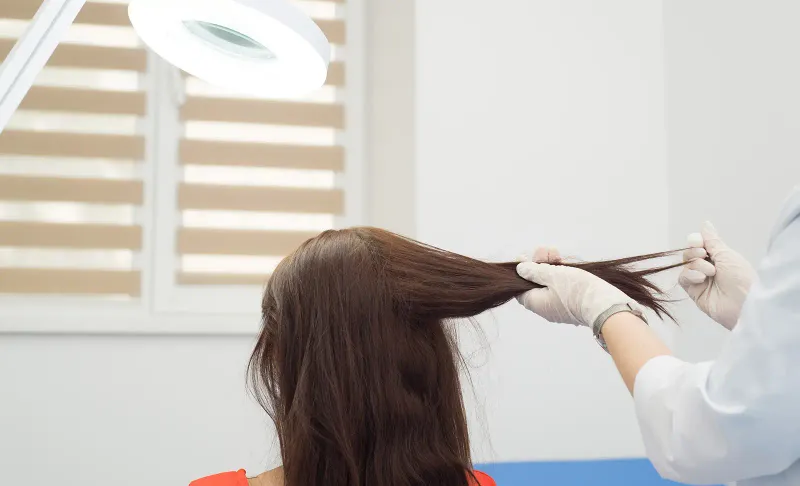Noticing more hair in your brush or a widening part can be alarming. Many people panic at the first sign of hair changes, but understanding whether you’re experiencing normal shedding or actual thinning makes all the difference in finding the right solution. Hair thinning and shedding might seem similar, but they’re actually distinct conditions with different causes, treatments, and outcomes.
1. Pattern Recognition
Hair thinning typically follows predictable patterns – men often see receding hairlines or crown baldness, while women experience widening parts or overall volume loss. The distribution isn’t random but follows genetic blueprints laid out in your DNA.
Shedding, however, happens all over your scalp without a specific pattern. You’ll notice hair falling from everywhere, not just certain spots. This randomness is a key clue that you’re dealing with temporary shedding rather than progressive thinning.
Related: -7 Straight-Hair Problems No One Talks About And 8 Easy Fixes That Shine
Recognizing these patterns early can help determine whether you’re facing a temporary phase or the beginning of a longer journey with your hair.
2. Root Examination
Grab a magnifying glass and look at fallen hairs. Thinned hairs often have miniaturized follicles – the roots appear smaller and thinner than normal, with tiny, barely visible bulbs. This shrinking process happens gradually as follicles weaken over time.
Shed hairs, by contrast, usually have a small white bulb at the end, indicating a healthy follicle that released the hair naturally. The white club-shaped root is actually a good sign, showing the hair completed its growth cycle normally.
This simple at-home test can provide valuable clues about what’s happening with your hair without expensive equipment.
3. Timeline Differences
Hair thinning operates on a slow timeline, often taking months or years before becoming noticeable to others. The gradual nature makes it easy to miss until significant changes have occurred. Many people only realize they’ve been thinning when comparing photos from different years.
Shedding happens more dramatically and suddenly. You might notice significantly more hair in your brush or shower drain within days or weeks. This rapid onset is actually a hopeful sign – sudden changes often indicate temporary conditions.
Keeping a photo journal of your hair can help track changes and provide valuable information for professionals if you seek help.
4. Regrowth Potential
One of the most heartening differences lies in recovery possibilities. Shed hair almost always grows back once the trigger resolves. Your follicles remain healthy and ready to produce new hair, just waiting for body conditions to normalize.
Thinning hair presents more challenges for regrowth. Once follicles miniaturize significantly, they may not return to producing thick, healthy strands without intervention. Early treatment becomes crucial for preserving remaining follicle function.
Understanding your regrowth potential helps set realistic expectations and determines whether you should focus on patience or proactive treatment approaches.
5. Trigger Identification
Shedding typically has identifiable triggers – childbirth, medication changes, illness, extreme stress, or dramatic weight loss. Once you connect the dots between a life event and your hair loss, you’ve taken the first step toward resolution.
Thinning usually stems from genetic predisposition, hormonal shifts like menopause, or advancing age. These factors work gradually and often in combination. The slow progression makes pinpointing a single cause more difficult.
Keeping a life events journal alongside hair observations can help reveal connections between what’s happening in your life and what’s happening on your scalp.
6. Density Changes
Hair density refers to how many strands grow per square inch of scalp. With thinning, your actual follicle count decreases over time as some follicles permanently stop producing hair. The reduction happens gradually but progressively.
During shedding episodes, your follicle count remains stable – you’re just experiencing more hairs in the shedding phase simultaneously. Your density potential hasn’t changed, even though temporarily you have fewer visible hairs.
Dermatologists can measure density precisely, but you can roughly assess it by looking at how much scalp is visible under bright light compared to previous years.
7. Strand Thickness Variations
Running your fingers through thinning hair reveals progressively finer, more delicate strands. Individual hairs literally become thinner in diameter – a process called miniaturization. You might notice these baby-fine hairs especially around your hairline or part.
With shedding, the strands that remain attached to your scalp maintain their normal thickness. The hairs you’re losing aren’t changing in diameter – there are just more of them falling out at once.
This subtle distinction helps explain why thinning hair often looks limp even with styling products, while post-shedding hair maintains its body once regrowth begins.
8. Family History Relevance
Pull out the family photo albums if you’re concerned about thinning hair. Genetic hair loss follows inheritance patterns, so looking at relatives can provide clues about your hair’s future. If multiple family members experienced similar patterns, genetics likely play a role in your situation.
Temporary shedding rarely shows family patterns. Your mother and grandmother might have experienced post-pregnancy shedding, but the timing and severity depend on individual circumstances, not shared genes.
Creating a family hair history can be surprisingly revealing – and sometimes reassuring if you discover relatives whose hair density stabilized rather than progressively declined.
9. Daily Hair Loss Counts
Normal daily hair loss ranges from 50-100 strands. During shedding episodes, this number can skyrocket to 300+ hairs daily, creating alarming shower drains and brushes full of hair. The dramatic increase happens because more follicles enter the shedding phase simultaneously.
With thinning, daily counts might actually appear normal or only slightly elevated. The issue isn’t how many hairs fall daily but that new hairs grow back thinner or don’t return at all. The gradual nature makes it harder to notice through daily counts.
Counting fallen hairs for a week can provide objective data about whether you’re experiencing above-normal shedding or simply becoming more aware of normal loss.
10. Treatment Approaches
Addressing hair thinning usually requires long-term strategies targeting the underlying causes. Medications like minoxidil or finasteride work by interrupting the miniaturization process and stimulating follicles. Consistency becomes key – most treatments need months or years of application.
For shedding, treatment focuses on eliminating triggers and supporting healthy hair growth through temporary interventions. Nutritional support, stress management, or simply waiting for hormones to normalize often resolves the issue without pharmaceutical intervention.
Understanding which condition you’re facing prevents wasting time and money on treatments designed for the wrong type of hair loss.
11. Seasonal Influences
Seasonal shedding follows natural rhythms, with many people experiencing increased fall hair loss as daylight hours decrease. This evolutionary pattern mimics animals’ coat changes and typically resolves within weeks as your body adjusts to seasonal shifts.
True hair thinning shows no seasonal pattern – it progresses regardless of the calendar. The lack of cyclical improvement distinguishes it from normal seasonal variations that affect most people to some degree.
Tracking hair changes across several seasons can reveal whether you’re experiencing natural cycles or a progressive condition that requires attention beyond waiting for the next season.
12. Scalp Visibility Changes
Stand under bright overhead lighting and take a selfie looking at your crown. With thinning, you’ll notice gradually increasing scalp visibility in specific areas – typically the crown, temples, or widening part line. These changes persist regardless of how you style your hair.
During shedding phases, scalp visibility increases more uniformly across your head. You might notice overall reduced density rather than specific problem areas. The good news? This visibility typically improves once the shedding phase ends.
Taking monthly scalp photos from the same angle and lighting can create an objective record of changes that memory alone might miss.
13. Age and Timing Factors
Age provides important context for hair changes. Thinning typically begins at predictable life stages – for men, often in their 20s-30s, while women frequently notice changes after menopause or in their 40s-50s. The timing aligns with hormonal shifts that affect follicle sensitivity.
Shedding can occur at any age and correlates more with specific events than life stages. A teenager can experience stress shedding just as a 50-year-old might shed after surgery – the timing connects to triggers rather than birthdays.
Considering your age alongside hair changes helps determine whether you’re experiencing expected age-related changes or something requiring further investigation.
14. Recovery Timeline Expectations
Managing expectations around recovery prevents unnecessary anxiety. Shedding typically resolves completely within 3-9 months as your hair cycle normalizes. You’ll notice decreased fallout first, followed by tiny new hairs emerging, then gradually lengthening to blend with existing hair.
Thinning hair recovery depends entirely on how early you begin treatment and which approaches you use. Without intervention, thinning typically continues progressively. With treatment, stabilization might take 6-12 months, with modest improvements possible over 1-2 years.
Setting realistic timeline expectations helps you evaluate whether your chosen approach is working rather than abandoning potentially effective treatments prematurely.
15. Psychological Impact Differences
Hair changes affect our self-image regardless of type, but the psychological impacts differ. Shedding often causes acute anxiety – the shocking amount of hair loss creates immediate fear. However, this anxiety typically resolves once you understand the temporary nature and see regrowth beginning.
Thinning tends to create longer-term adjustment challenges as you reconcile with changing appearance over time. The progressive nature means continually adapting to new normals rather than returning to a previous state.
Recognizing these emotional differences helps you seek appropriate support – whether short-term reassurance for shedding or longer-term acceptance strategies for thinning.
16. Professional Diagnosis Methods
Dermatologists use different approaches to diagnose these conditions. For suspected thinning, they typically perform dermoscopy (magnified scalp examination) and may recommend a small scalp biopsy to examine follicle health microscopically. These tests reveal miniaturization patterns invisible to the naked eye.
Diagnosing shedding often involves blood tests checking nutritional status, thyroid function, and hormone levels to identify triggers. The hair pull test – where the doctor gently tugs hair to see how many strands release – helps quantify active shedding.
Understanding these diagnostic differences helps you prepare for appointments and ensures you see the right specialist for your specific situation.


